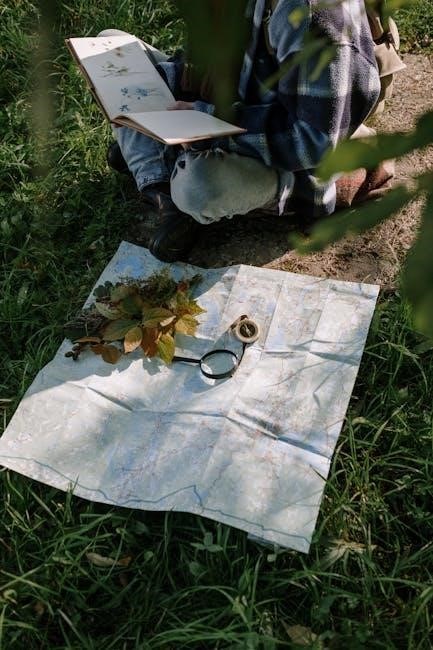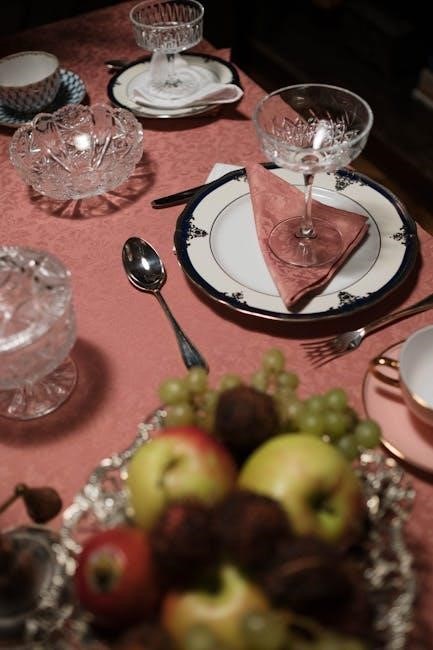A Botanist’s Guide to Parties and Poisons by Kate Khavari is a captivating historical mystery set in 1920s London, blending botany, murder, and academia with wit and charm.
Overview of the Book
A Botanist’s Guide to Parties and Poisons is a historical mystery set in 1923 London, following Saffron Everleigh, a trailblazing female botanist navigating academia, sexism, and murder. When a professor’s wife is poisoned at a university party, Saffron’s mentor becomes the prime suspect. Determined to clear his name, she delves into a world of deadly plants, hidden motives, and societal pressures. With the help of enigmatic researcher Alexander Ashton, Saffron must use her botanical expertise to uncover the truth before it’s too late.
Historical Context
The story is set in 1920s London, a period of significant social change. Women were beginning to break into male-dominated fields like academia and science, facing both curiosity and resistance. The backdrop of post-World War I London influences the characters’ struggles with societal expectations and personal ambition. Botany, a growing field at the time, plays a central role in the mystery, reflecting the era’s fascination with exploration and scientific discovery.
Botany and Its Role in the Story
Botany is central to the narrative, serving as both a scientific pursuit and a plot device. The protagonist, Saffron Everleigh, uses her botanical knowledge to investigate a poisoning, highlighting the field’s practical applications. The story explores the dual role of plants as sources of life and death, reflecting the era’s fascination with botanical discoveries. Through Saffron’s expertise, botany becomes a tool for empowerment, enabling her to navigate a male-dominated academic world and uncover the truth behind the mysterious poisoning.

Botany in the 1920s
The 1920s saw botany flourish with expedition discoveries, advancements in plant classification, and practical applications in medicine and industry, despite limited opportunities for women in the field.
Significance of Botany in the 1920s
Botany in the 1920s played a vital role in scientific and societal progress, offering solutions to medical and agricultural challenges. Expeditions expanded plant classification, while women like Saffron Everleigh broke barriers, despite facing sexism. Botany’s practical applications in medicine and industry highlighted its importance, making it a cornerstone of scientific inquiry during this transformative era.
Botany as a Science and Its Applications
Botany in the 1920s was a thriving scientific field, driving advancements in medicine, agriculture, and exploration. Researchers like Saffron Everleigh utilized botanical knowledge to identify and classify plants, unlocking their potential for healing and discovery. This era saw the rise of botanical gardens and expeditions, which expanded understanding of plant species and their uses. Botany’s practical applications in developing remedies and poisons highlight its dual role in advancing science and solving mysteries, as depicted in the story.
Botanical Discoveries of the Era
The 1920s witnessed significant botanical discoveries, driven by global expeditions and advancements in scientific research. Explorers brought back exotic plant species, expanding knowledge of flora worldwide. Universities and botanical gardens became hubs for classification and experimentation, revealing new uses for plants in medicine and industry. The era also saw a growing fascination with poisonous plants, as scientists studied their toxic compounds for both lethal and therapeutic purposes, reflecting the duality of botanical discovery during this period.

The Role of Parties
Parties in 1920s London served as vibrant social hubs, blending academia and intrigue, where relationships were forged and tensions simmered, often setting the stage for mystery;
Parties as Social Gatherings
In 1920s London, parties were essential social gatherings where academia and high society intertwined. These events, often grand and meticulously planned, provided a backdrop for networking, romance, and subtle power plays. For Saffron Everleigh, such gatherings were both opportunities and challenges, as they highlighted her unique position as a woman in a male-dominated field. The parties in the story serve as a blend of elegance and tension, where conversations about botany and university expeditions often masked underlying rivalries and secrets, setting the stage for the unfolding mystery.
Parties in 1920s London
Parties in 1920s London were vibrant, reflecting the era’s cultural shift and social change. They were spaces where jazz music filled the air, and flappers challenged traditional norms. For Saffron Everleigh, attending such events meant navigating a world of societal expectations and academic politics. These gatherings, often hosted by wealthy intellectuals, were not just for pleasure but also served as platforms for professional advancement and subtle rivalries. The parties in the novel mirror the era’s glamour and underlying tensions, providing a rich backdrop for the mystery to unfold.
Botany and Parties
Botany and parties intersect in the story through Saffron’s unique expertise, which becomes a crucial tool in unraveling the mystery. At social gatherings, her knowledge of plants often helps identify potential poisons or medicinal uses, showcasing botany’s dual role in beauty and danger. The opulent 1920s parties, with their elaborate floral arrangements, serve as a backdrop where botany’s significance is both aesthetic and deadly, reflecting the era’s fascination with nature and its hidden risks.

Poisonous Plants
Poisonous plants play a central role in the mystery, serving as both intricate plot devices and deadly weapons. Their toxic properties, often misunderstood, drive the story’s tension and suspense forward.
Common Poisonous Plants in the 1920s
In the 1920s, plants like deadly nightshade, hemlock, and foxglove were well-documented for their toxic properties. These species often appeared in gardens and were subtly lethal, making them plot devices in the story. Botany experts like Saffron Everleigh could identify and utilize such plants, showcasing their dual role as beauty and danger; Their presence in the era’s flora added layers of tension and mystery, reflecting the deadliest aspects of nature’s creations.
Uses of Poisonous Plants
Poisonous plants in the 1920s served dual purposes, often blurring the lines between beauty and danger. Species like deadly nightshade and hemlock were not only lethal but also had medicinal uses when properly diluted. In the story, these plants become tools for murder, highlighting their deadly potential. Saffron Everleigh’s knowledge of botany allows her to uncover their role in the poisoning, showcasing their dual nature as both scientific specimens and instruments of crime. Their versatility in both medicine and malice underscores their significance in the era.
Botanical Poisons in the Story
In A Botanist’s Guide to Parties and Poisons, botanical toxins play a central role in the plot. The poisoning at the university party is traced to a rare, fictional plant specimen, the “Lightning Vine,” brought back from an expedition. This plant’s unique toxicity becomes a key clue for Saffron Everleigh as she investigates. The story highlights how botanical knowledge can be both a tool for discovery and a weapon, blending science with suspense to unravel the mystery surrounding the deadly incident.

Saffron Everleigh
Saffron Everleigh, a trailblazing botanist in 1920s London, navigates sexism and academia with determination, driving the story with her resilience and intellect.
Character Background
Saffron Everleigh, a determined and ambitious botanist, is one of the first women to work in the male-dominated botany department at the University of London. Born into a family of academics, she follows in her father’s footsteps, though her career choice estranges her from her wealthy grandparents, who disapprove of her profession. Saffron’s resilience is shaped by the sexism and harassment she faces daily, making her fiercely independent and resourceful. Her mentor, Dr. Maxwell, plays a pivotal role in her career, and her friendship with Elizabeth provides emotional support. Saffron’s journey is marked by her relentless pursuit of truth and justice, even as she navigates the complexities of her personal and professional life.
Challenges Faced by Saffron
Saffron Everleigh faces numerous challenges as a woman in a male-dominated academic field during the 1920s. She endures sexism, belittlement, and sexual harassment, struggling to gain respect for her botanical expertise. Additionally, her investigation into the poisoning puts her at risk, as she confronts societal norms and institutional barriers. Her determination to clear her mentor’s name adds pressure, while navigating her personal life and ambitions further complicates her journey. These obstacles shape her resilience and drive to succeed in a world stacked against her.
Saffron’s Knowledge of Botany
Saffron Everleigh’s expertise in botany is central to her character, shaped by her father’s legacy and her own academic pursuits. Her vast knowledge of plants, including their toxic properties, proves crucial in solving the mystery. Saffron uses her understanding of botanical specimens to identify poisons and trace their origins, leveraging her skills in greenhouses and gardens. Her scientific background not only aids her investigation but also highlights her intellectual contributions in a male-dominated field, showcasing her as a trailblazer in 1920s academia.

The Mystery Unfolds
The poisoning at the university party sparks a race against time for Saffron to clear her mentor’s name, unraveling a tangled web of secrets and botanical clues.
The Poisoning Incident
The story begins with Saffron Everleigh attending a university dinner party, where Mrs. Henry, the wife of a professor, collapses after being poisoned. The incident shocks the academic community, and suspicion quickly falls on Dr. Maxwell, Saffron’s mentor, due to his recent argument with Dr. Henry. As evidence mounts against him, Saffron is determined to clear his name, diving into a world of botanical clues and deadly secrets. Her knowledge of plants becomes crucial in unraveling the mystery behind the poisoning.
Investigation and Clues
Saffron’s investigation leads her to explore greenhouses, gardens, and university archives, uncovering hidden motives and secrets. With Alexander Ashton’s help, she examines toxic plants and traces the origins of the poison used. Each clue reveals a web of academic rivalries and personal vendettas, narrowing down the list of suspects. Saffron’s botanical expertise proves pivotal in identifying the poison’s source, inching closer to the truth while navigating the treacherous social dynamics of 1920s academia.
Uncovering the Truth
As Saffron delves deeper, she uncovers a complex trail of deceit and betrayal, revealing the true culprit behind the poisoning. The killer’s identity shocks her, exposing a tangled web of motives tied to jealousy, ambition, and past grievances. With the truth finally revealed, Saffron clears her mentor’s name, showcasing her resilience and intellect. The resolution leaves room for future mysteries, solidifying her role as a detective in both botany and crime.

Supporting Characters
Dr; Maxwell, Saffron’s mentor, faces wrongful accusations, while Alexander Ashton, a mysterious researcher, assists her investigation. Other key characters include colleagues and acquaintances shaping the plot’s dynamics.
Dr. Maxwell
Dr. Maxwell is a pivotal figure in Saffron’s life, serving as her mentor and a respected botanist. His expertise in rare plants and contentious disputes with colleagues, including Dr. Henry, make him the prime suspect in the poisoning. As evidence mounts against him, Saffron must navigate the complexities of their professional relationship to clear his name. Dr. Maxwell’s past expeditions and prickly demeanor add layers to his character, making him both a victim of circumstance and a man with secrets that complicate the investigation. His fate hinges on Saffron’s determination and botanical knowledge.
Alexander Ashton
Alexander Ashton is a fellow researcher who joins Saffron in unraveling the mystery. His enigmatic presence and willingness to help, despite reservations, add depth to the story. With his dark past and war scars, Ashton’s character is both intriguing and complex. His impending departure for South America hints at future plot developments. His interactions with Saffron suggest a potential romantic subplot, enriching the narrative with tension and emotion.
Other Key Characters
Beyond Saffron and Alexander, the story introduces a cast of intriguing figures. Saffron’s roommate, Elizabeth, offers loyal support and provides a glimpse into her personal life. Dr. Henry, whose wife’s poisoning sparks the mystery, adds tension with his volatile arguments. Saffron’s father, a respected botany professor, influences her career aspirations. These characters weave a rich tapestry, highlighting societal dynamics and academic rivalries, while deepening the narrative’s emotional and intellectual layers.

Historical and Social Context
Set in 1920s London, the novel explores the challenges of women in academia, societal pressures, and the evolving role of botany, reflecting the era’s gender barriers and traditions.
Gender Roles in 1920s Academia
In 1920s academia, women faced significant barriers, often marginalized and underestimated. Saffron Everleigh, as one of the first female botanists at University College London, encounters sexism, belittlement, and sexual harassment, highlighting the patriarchal norms of the time. Her journey reflects the struggle for recognition in male-dominated fields, where women’s contributions were frequently overlooked. Despite these challenges, Saffron’s determination and intellect showcase her resilience and ambition in a society resistant to change.
Social Pressures and Expectations
Set in 1920s London, the novel vividly portrays the societal norms that constrained women, particularly in academia. Saffron Everleigh, a trailblazing botanist, faces pressures to conform to traditional roles, with her wealthy grandparents disapproving of her academic pursuits. The societal expectation that women prioritize marriage and domesticity looms large, while Saffron’s ambition and independence challenge these norms. Her journey reflects the tension between personal aspirations and the rigid expectations of her time, highlighting the struggles of women in male-dominated fields.
Academic Challenges
In the male-dominated academic world of 1920s London, Saffron Everleigh faces significant challenges as a female botanist. Her expertise is often underestimated, and she must continually prove her capabilities to gain respect. The university’s patriarchal environment fosters skepticism and bias, with colleagues questioning her qualifications and contributions. Additionally, her mentor, Dr. Maxwell, becomes embroiled in a poisoning scandal, further complicating her professional journey. Saffron’s determination to succeed is tested as she navigates these obstacles while striving to advance her botanical research and career.
A Botanist’s Guide to Parties and Poisons offers a fresh blend of mystery, botany, and historical fiction, appealing to both newcomers and seasoned fans of the genre.
Impact of the Book
A Botanist’s Guide to Parties and Poisons has made a notable impact by blending STEM themes with historical mystery, appealing to fans of Deanna Raybourn and Anna Lee Huber. Its unique focus on botany and women in academia highlights the challenges faced by female scholars in the 1920s, resonating with readers who enjoy strong, independent protagonists. The book’s success lies in its ability to balance intellectual intrigue with relatable characters, making it a standout in the historical mystery genre.
Themes and Messages
The book explores themes of gender roles, ambition, and societal constraints through Saffron’s journey as a female botanist in a male-dominated field. It highlights the challenges women faced in academia during the 1920s, emphasizing resilience and determination. The story also delves into the pursuit of truth and justice, blending personal growth with the mystery of poisoning. These themes resonate with readers, offering a compelling narrative about overcoming obstacles and standing up for one’s beliefs in a rigid societal framework.
Future of the Series
The Saffron Everleigh Mysteries series promises further intriguing adventures, blending botany, mystery, and historical charm. With three books already released, the series continues to captivate readers, hinting at deeper character development and new challenges for Saffron and Alexander. The blend of STEM themes, historical fiction, and romance ensures a compelling future, offering fans more of the clever plots and strong female leads they’ve come to admire. The series is poised to grow, exploring more of Saffron’s botanical expertise and the evolving societal landscape of the 1920s.

Further Reading
For fans of historical mysteries with STEM twists, consider The Lost Apothecary and Dead Dead Girls, which share similar themes of intrigue and strong female leads.
Recommended Books
For fans of A Botanist’s Guide to Parties and Poisons, consider The Lost Apothecary by Sarah Penner, a historical mystery blending botany and suspense. Dead Dead Girls by Nekesa Afia offers a similar mix of intrigue and strong female leads. For STEM-themed mysteries, try The Alice Network by Kate Quinn or The Poison Tree by Erin Kelly, both featuring complex characters and historical settings. These books share themes of wit, academia, and murder, appealing to fans of Khavari’s work.
Related Topics
Exploring the intersection of botany and mystery, readers may enjoy delving into historical botany, women in STEM, and 1920s academia. Themes of poisoning in literature, the role of parties in social dynamics, and the challenges faced by female academics are also intriguing areas of study. For a deeper dive, consider historical fiction centered on botany or mysteries involving scientific discoveries. These topics provide a richer understanding of the book’s unique blend of botany, mystery, and historical context.
Additional Resources

For further exploration, readers can visit Goodreads for reviews and discussions on A Botanist’s Guide to Parties and Poisons. Historical botany enthusiasts may enjoy resources like “The Lost Apothecary” by Sarah Penner. Websites like Publishers Weekly and book blogs offer insightful interviews with Kate Khavari, shedding light on her writing process. Additionally, STEM-themed mysteries and historical fiction novels like “A Magic Steeped in Poison” by Judy I. Lin provide similar blends of science and intrigue for deeper exploration.
